 Ironically, my first posted example of discordant redshifts could really serve as the one and only example I should have to post. It is not only one of the best examples of visibly connected extragalactic objects possessing two widely different redshifts, it is also a perfect example of the current scientific community’s blatant refusal to acknowledge obvious observational evidence. The photograph to the left shows the barred spiral galaxy NGC 4319 with the nearby quasar Markarian 205 to the upper right. I reduced the image size of the original uncompressed TIFF file and saved it as an image file in PNG format in order to fit it on this page and avoid any compression artifacts. I also saved all subsequent modifications of the image in PNG format to avoid compression artifacts. The original photograph can be freely downloaded in many different formats and sizes from the Hubble Space Telescope website.
Ironically, my first posted example of discordant redshifts could really serve as the one and only example I should have to post. It is not only one of the best examples of visibly connected extragalactic objects possessing two widely different redshifts, it is also a perfect example of the current scientific community’s blatant refusal to acknowledge obvious observational evidence. The photograph to the left shows the barred spiral galaxy NGC 4319 with the nearby quasar Markarian 205 to the upper right. I reduced the image size of the original uncompressed TIFF file and saved it as an image file in PNG format in order to fit it on this page and avoid any compression artifacts. I also saved all subsequent modifications of the image in PNG format to avoid compression artifacts. The original photograph can be freely downloaded in many different formats and sizes from the Hubble Space Telescope website.
The caption on this page claims that these two objects are completely unrelated and unconnected. This is due to the assumption that the redshift of NGC 4319 at 0.004526 z would place its distance at approximately 80 million light-years from Earth using a so-called Hubble Constant value of 55 (km/s)/Mpc while the redshift of Markarian 205 at 0.070846 z supposedly indicates a distance of almost 1.2 billion light-years from Earth. However, careful analysis of the photograph clearly shows that the huge difference between these objects’ distances and the accepted interpretation of these objects’ redshifts cannot possibly be correct.
| If you look closely at the gap between the two the objects as shown in this section from the original downloaded and unaltered image you can just make out a very faint stream of matter bridging the two supposedly unconnected objects. How well you will be able to make out this bridge will depend on the contrast visible for your particular monitor. | 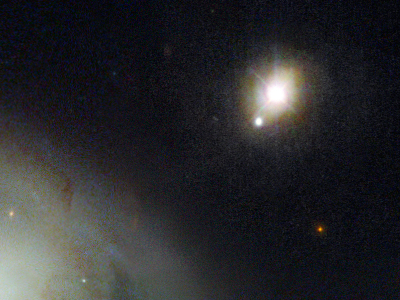 |
| In this image I have taken the above section and modified its color palette to produce a false color image. I simply opened the image in Adobe Photoshop and chose Image from the menu bar then Adjustments > Gradient Map… and set the color gradient to one of the options available. Changing the color gradient has not modified the pixel positions of the original photograph but has set their assigned colors to a smaller and more visible range according to their brightness. In this color palette the bridge of matter is much more visible. | 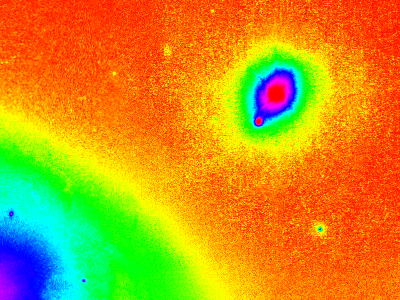 |
| Several different preset color gradients are available by default in Photoshop. Here is the same section of the photograph set to another one of these preset options. Again, no pixels have been moved, added or deleted. Only the colors assigned to the pixels have been changed, making subtle differences in brightness between pixels more visible. In this particular palette it is even easier to see the stream of matter extending between NCG 4319 and Markarian 205. | 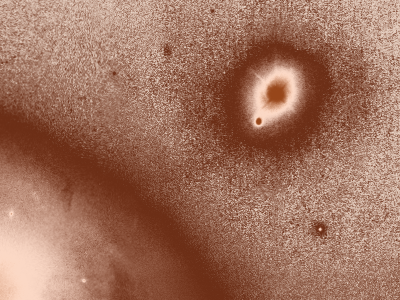 |
| Posterizing (Image > Adjustments > Posterize…) the section of photograph first before changing its color gradient further reduces the range of colors available so that only the largest differences in brightness are visible. Although the density of the bridge of matter has been greatly reduced it is still clearly visible in the resulting image. | 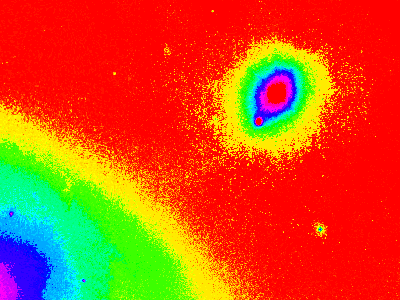 |
| Changing the color gradient of the posterized image to a different palette makes the matter bridge between NGC 4319 and Markarian 205 even more obvious even though fewer overall pixels are visible in the image. The bulge at the bottom left edge of Markarian 205 is particularly visible in this image. It is also very clear that the stream of matter exits Markarian 205 at the location of this peculiar bulge. | 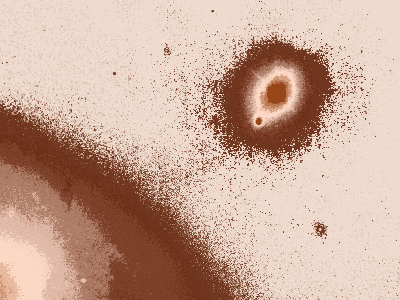 |
The caption on the above mentioned Hubble Space Telescope web page also claims that Markarian 205 is over a billion light years further away than NGC 4319 because the ultraviolet light from Markarian 205 was “dimmed” as it passed through the gas of NGC 4319. Although there is clearly a bridge of matter connecting the two objects it is still possible that Markarian 205 is slightly further away from Earth than NGC 4319. Even if the distance is only hundreds of light years instead of over of a billion it is possible that the ultraviolet light of Markarian 205 was dimmed, or more precisely absorbed, by the interstellar gas of NGC 4319 on its way to us. It is also possible that if Markarian 205 was ejected from the core of NGC 4319, as has been proposed by Dr. Halton Arp, it has pulled some of the gas of NGC 4319 out with it and that is what is absorbing its ultraviolet radiation.
The caption also mentions the the small bright object located just to the lower left of the core of Markarian 205. Although this compact galaxy is obviously interacting with Markarian 205 and falls directly in line between its core and outer bulge and the connecting bridge there is no redshift measurement available for this object. Obviously one of the most important steps in the future analysis of these objects is to obtain the redshift of this compact companion galaxy and see how it compares to the redshifts of Markarian 205 and NGC 4319.
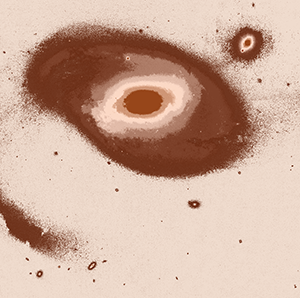
The Hubble Space Telescope photographs of NGC 4319 and Markarian 205 posted by NASA have always looked suspiciously underexposed to me, especially compared to those made in the past by other telescopes. But I have demonstrated that using some basic image editing tools it is very easy to make these dim pixels highly visible, thus exposing the connecting bridge of matter. Of course I am not the first person to edit photographs of NGC 4319 and Markarian 205 in order to highlight the connecting bridge between the two objects. I am not even the first person to edit this particular Hubble Space Telescope photograph. These two objects feature prominently in Dr. Halton Arp’s books Quasars, Redshifts and Controversies (Interstellar Media, 1987), Seeing Red: Redshifts, Cosmology and Academic Science (Apeiron, 1998) and Catalogue of Discordant Redshift Associations (Apeiron, 2003) and is displayed in different color palettes on the cover of all three books. These two objects are also discussed at length in the introduction to Jeff Kanipe and Dennis Webb’s book The Arp Atlas of Peculiar Galaxies (Willmann-Bell, 2006) even though neither one is an actual Arp catalog object. These books feature detailed images and photographs including some in non-optical wavelengths. I highly recommend all of these books to anyone who is looking for more information concerning NGC 4319 and Markarian 205 and the controversy surrounding the connection between them.
Questions or comments about this example? Do you have an example you would like to contribute? Your input is not only welcomed, it is encouraged.
Thanks for reading!
Shannon
